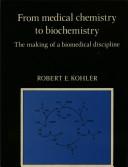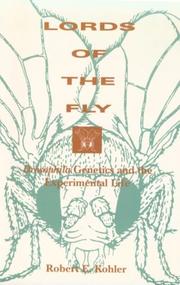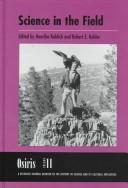| Listing 1 - 10 of 17 | << page >> |
Sort by
|

ISBN: 0521243122 0521090474 0511897316 Year: 1982 Publisher: Cambridge New York Cambridge University Press
Abstract | Keywords | Export | Availability | Bookmark
 Loading...
Loading...Choose an application
- Reference Manager
- EndNote
- RefWorks (Direct export to RefWorks)
This penetrating case study of institution building and entrepreneurship in science shows how a minor medical speciality evolved into a large and powerful academic discipline. Drawing extensively on little-used archival sources, the author analyses in detail how biomedical science became a central part of medical training and practice. The book shows how biochemistry was defined as a distinct discipline by the programmatic vision of individual biochemists and of patrons and competitors in related disciplines. It shows how discipline builders used research programmes as strategies that they adapted to the opportunities offered by changing educational markets and national medical reform movements in the United States, Britain and Germany. The author argues that the priorities and styles of various departments and schools of biochemistry reflect systematic social relationships between that discipline and biology, chemistry and medicine. Science is shaped by its service roles in particular local contexts: This is the central theme. The author's view of the political economy of modern science will be of interest to historians and social scientists, scientific and medical practitioners, and anyone interested in the ecology of knowledge in scientific institutions and professions.
Biochemistry --- Biological chemistry --- Chemical composition of organisms --- Organisms --- Physiological chemistry --- Biology --- Chemistry --- Medical sciences --- History --- Composition --- United States --- Biochemistry - History. --- Biochemistry - United States - History. --- Medicine. --- Arts and Humanities --- History. --- Medicine --- History (not cas)

ISBN: 0226450627 0226450635 9780226450629 9780226450636 Year: 1994 Publisher: Chicago, Ill.: University of Chicago press,
Abstract | Keywords | Export | Availability | Bookmark
 Loading...
Loading...Choose an application
- Reference Manager
- EndNote
- RefWorks (Direct export to RefWorks)
Hommes de science --- Scientifiques --- Scientists --- Wetenschappers --- Research --- Drosophila --- Methodology --- Scientists. --- Research. --- Methodology. --- Professional employees --- Drosophilidae --- Fruit-flies --- Drosophila - Research. --- Research - Methodology --- Drosophila - Research --- Genetique --- Drosophiles --- Recherche scientifique --- Histoire --- Methodologie --- Recherche

ISBN: 0691125392 9780691125398 1306046203 1400849713 9781400849710 Year: 2006 Publisher: New York
Abstract | Keywords | Export | Availability | Bookmark
 Loading...
Loading...Choose an application
- Reference Manager
- EndNote
- RefWorks (Direct export to RefWorks)
We humans share Earth with 1.4 million known species and millions more species that are still unrecorded. Yet we know surprisingly little about the practical work that produced the vast inventory we have to date of our fellow creatures. How were these multitudinous creatures collected, recorded, and named? When, and by whom? Here a distinguished historian of science tells the story of the modern discovery of biodiversity. Robert Kohler argues that the work begun by Linnaeus culminated around 1900, when collecting and inventory were organized on a grand scale in natural history surveys. Supported by governments, museums, and universities, biologists launched hundreds of collecting expeditions to every corner of the world. Kohler conveys to readers the experience and feel of expeditionary travel: the customs and rhythms of collectors' daily work, and its special pleasures and pains. A novel twist in this story is that survey collecting was rooted not just in science but also in new customs of outdoor recreation, such as hiking, camping, and sport hunting. These popular pursuits engendered a wide scientific interest in animals and plants and inspired wealthy nature-goers to pay for expeditions. The modern discovery of biodiversity became a reality when scientists' desire to know intersected with the culture of outdoor vacationing. General readers as well as scholars will find this book fascinating.
Natural history --- Biological specimens --- History. --- Collectors and collecting --- Specimens, Biological --- Biological products --- Biobanks --- Collectors and collecting&delete& --- History

ISBN: 1282901958 9786612901959 0226450112 9780226450117 9781282901957 0226450090 9780226450094 0226450104 9780226450100 Year: 2002 Publisher: Chicago University of Chicago Press
Abstract | Keywords | Export | Availability | Bookmark
 Loading...
Loading...Choose an application
- Reference Manager
- EndNote
- RefWorks (Direct export to RefWorks)
What is it like to do field biology in a world that exalts experiments and laboratories? How have field biologists assimilated laboratory values and practices, and crafted an exact, quantitative science without losing their naturalist souls? In Landscapes and Labscapes, Robert E. Kohler explores the people, places, and practices of field biology in the United States from the 1890's to the 1950's. He takes readers into the fields and forests where field biologists learned to count and measure nature and to read the imperfect records of "nature's experiments." He shows how field researchers use nature's particularities to develop "practices of place" that achieve in nature what laboratory researchers can only do with simplified experiments. Using historical frontiers as models, Kohler shows how biologists created vigorous new border sciences of ecology and evolutionary biology.
Biology --- Field biology --- Nature study --- Fieldwork. --- Field work --- Methodology --- Fieldwork --- History. --- Research --- naturalists, methodology, research, scholarship, quantitative science, scientific values, laboratory, field biologists, experiments, ecology, evolutionary biology, records, nature, data, environment, measurements, counting, quantifiable, place, biometry, genetics, vivaria, biological farms, marine stations, hybrid integration, speciation, species, geography, nonfiction.
Book
ISBN: 9780226617985 Year: 2019 Publisher: Chicago ; London : The University of Chicago Press,
Abstract | Keywords | Export | Availability | Bookmark
 Loading...
Loading...Choose an application
- Reference Manager
- EndNote
- RefWorks (Direct export to RefWorks)
Context and situation always matter in both human and animal lives. Unique insights can be gleaned from conducting scientific studies from within human communities and animal habitats. Inside Science is a novel treatment of this distinctive mode of fieldwork. Robert E. Kohler illuminates these resident practices through close analyses of classic studies: of Trobriand Islanders, Chicago hobos, corner boys in Boston’s North End, Jane Goodall’s chimpanzees of the Gombe Stream Reserve, and more. Intensive firsthand observation; a preference for generalizing from observed particulars, rather than from universal principles; and an ultimate framing of their results in narrative form characterize these inside stories from the field. Resident observing takes place across a range of sciences, from anthropology and sociology to primatology, wildlife ecology, and beyond. What makes it special, Kohler argues, is the direct access it affords scientists to the contexts in which their subjects live and act. These scientists understand their subjects not by keeping their distance but by living among them and engaging with them in ways large and small. This approach also demonstrates how science and everyday life—often assumed to be different and separate ways of knowing—are in fact overlapping aspects of the human experience. This story-driven exploration is perfect for historians, sociologists, and philosophers who want to know how scientists go about making robust knowledge of nature and society.
Life sciences --- Nature observation --- Nature observation. --- Life scientists. --- Sciences de la vie --- Nature --- Spécialistes des sciences de la vie --- Fieldwork --- Recherche sur le terrain --- Observation

ISBN: 0226450600 0226450619 Year: 1991 Publisher: Chicago : University of Chicago Press,
Abstract | Keywords | Export | Availability | Bookmark
 Loading...
Loading...Choose an application
- Reference Manager
- EndNote
- RefWorks (Direct export to RefWorks)
Science --- Scientists. --- Naturalists --- Sciences --- Scientifiques --- Naturalistes --- History --- Endowments --- Histoire --- Fondations

ISBN: 9781400849710 9780691125398 Year: 2013 Publisher: Princeton, N.J. Princeton University Press
Abstract | Keywords | Export | Availability | Bookmark
 Loading...
Loading...Choose an application
- Reference Manager
- EndNote
- RefWorks (Direct export to RefWorks)
Book
ISBN: 9780511897313 9780521243124 9780521090476 Year: 1982 Publisher: Cambridge Cambridge University Press
Abstract | Keywords | Export | Availability | Bookmark
 Loading...
Loading...Choose an application
- Reference Manager
- EndNote
- RefWorks (Direct export to RefWorks)

ISBN: 0226460029 0226460037 Year: 1996 Publisher: Chicago : The Univ. of Chicago Press,
Abstract | Keywords | Export | Availability | Bookmark
 Loading...
Loading...Choose an application
- Reference Manager
- EndNote
- RefWorks (Direct export to RefWorks)
Book
Year: 1996 Publisher: Ithaca (N.Y.) Cornell university press
Abstract | Keywords | Export | Availability | Bookmark
 Loading...
Loading...Choose an application
- Reference Manager
- EndNote
- RefWorks (Direct export to RefWorks)
| Listing 1 - 10 of 17 | << page >> |
Sort by
|

 Search
Search Feedback
Feedback About UniCat
About UniCat  Help
Help News
News